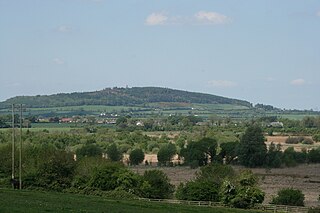 W
WThe Hill of Allen is a volcanic hill situated in the west of County Kildare, Ireland, beside the village of Allen. According to Irish Mythology it was the seat of the hunter-warrior Fionn mac Cumhaill and the Fianna. The site is currently part-owned by Roadstone Dublin Limited and extensive quarrying has noticeably changed the profile of the hill.
 W
WCounty Antrim is one of six counties that form Northern Ireland. Adjoined to the north-east shore of Lough Neagh, the county covers an area of 3,046 square kilometres (1,176 sq mi) and has a population of about 618,000. County Antrim has a population density of 203 people per square kilometre or 526 people per square mile. It is also one of the thirty-two traditional counties of Ireland, as well as part of the historic province of Ulster.
 W
WThe Breadknife is a volcanic dyke in New South Wales, Australia. It is nearly 90 metres high, but often is only 4 m wide, which is particularly rare. The Breadknife was part of a large shield volcano, that first erupted about 17 million years ago and stopped about 13 million years ago. It is composed of peralkaline trachyte.
 W
WBreidden Hill is an extinct volcanic hill in Powys, Wales, near the town of Welshpool. It is immediately surrounded by the villages of Trewern, Middletown, Criggion, Crew Green and Llandrinio. The peak of the hill reaches to 367 metres (1,204 ft). Footpaths which lead up to the summit provide excellent 360 degree views over Powys and over the border with England to the Shropshire Plain.
 W
WThe Drakensberg is the name given to the eastern portion of the Great Escarpment, which encloses the central Southern African plateau. The Great Escarpment reaches its greatest elevation – 2,000 to 3,482 metres within the border region of South Africa and Lesotho.
 W
WThe Giant's Causeway is an area of about 40,000 interlocking basalt columns, the result of an ancient volcanic fissure eruption. It is located in County Antrim on the north coast of Northern Ireland, about three miles (4.8 km) northeast of the town of Bushmills.
 W
WThe Keweenaw Peninsula is the northernmost part of Michigan's Upper Peninsula. It projects into Lake Superior and was the site of the first copper boom in the United States, leading to its moniker of "Copper Country." As of the 2000 census, its population was roughly 43,200. Its major industries are now logging and tourism, as well as jobs related to Michigan Technological University and Finlandia University.
 W
WLambay Island, often simply Lambay, lies in the Irish Sea off the coast of north County Dublin in Ireland. The island, the largest off the east coast of Ireland, is four kilometres (2 mi) offshore from the headland at Portrane and is the easternmost point of the province of Leinster. Of volcanic origin, it has been inhabited since the prehistoric period and has been the subject of multiple archaeological studies. Lambay has notable populations of seabirds, a range of local fauna, some not found elsewhere in Ireland, and a colony of wallabies, as well as more than 300 plant varieties, and was the subject of major studies of flora and bird, and a major multidisciplinary study of flora and fauna between 1905 to 1907. The island is privately owned by a trust for members of certain branches of the Baring family and managed by the current Baron Revelstoke. It has a very small permanent population and few buildings but hosts some day visitors and short-stay guests, and there is a working farm.
 W
WRathlin Island is an island and civil parish off the coast of County Antrim in Northern Ireland. It is Northern Ireland's northernmost point.
 W
WRoundton Hill is a rounded, steep sided, 1,210 feet (370 m) hill, volcanic in origin, in the easternmost part of old Montgomeryshire, Wales, which juts into the English border near Church Stoke. It is managed as a nature reserve by the Montgomeryshire Wildlife Trust, who acquired it in 1985.